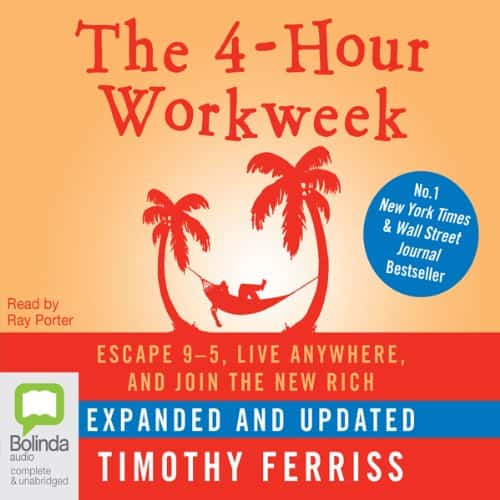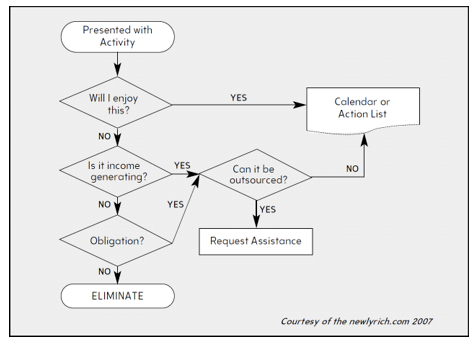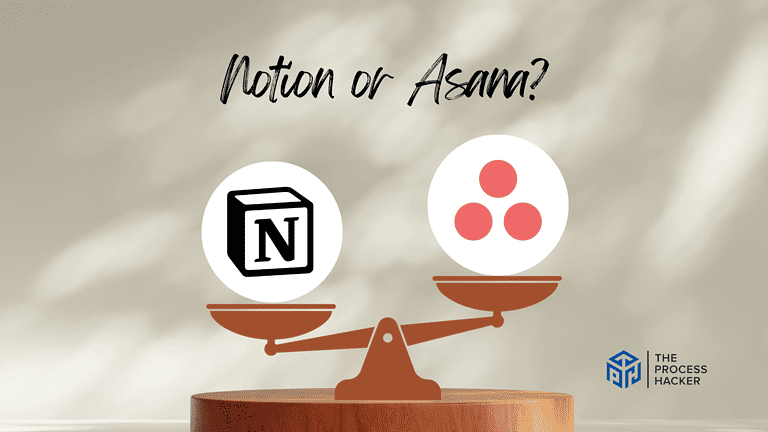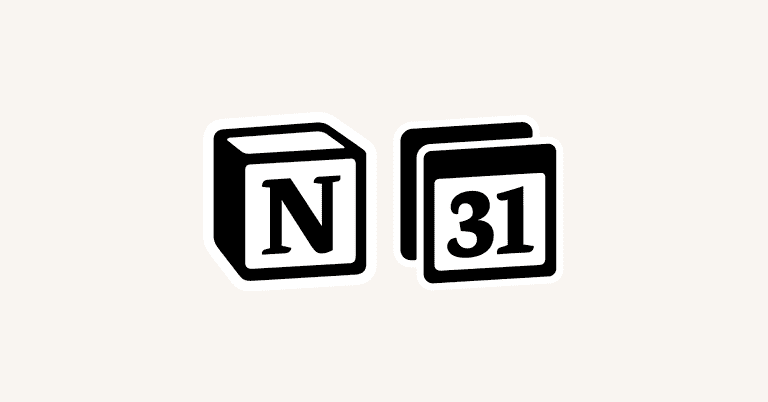The 4-Hour Workweek by Tim Ferriss | Book Summary
The 4-Hour Workweek by Tim Ferriss has revolutionized how we think about work and life. The book offers practical advice on how to create a lifestyle career or business that allows for more flexibility, freedom, and overall satisfaction with one’s life.
The concept of the 4-Hour Workweek has inspired people all over the world to break free from the standard 9-to-5 lifestyle and make a living while doing something they enjoy. Whether you are an entrepreneur, remote worker, or just an individual looking for a change, The 4-Hour Workweek is one of the best business books out there and will be powerful.
Download The PDF Book Summary For The 4-Hour Workweek By Tim Ferriss
It is an excellent source of information for creating an ideal work schedule that perfectly combines money, time, and freedom for maximum progress and fulfillment.
Buy The 4-Hour Workweek on Amazon

The 4-Hour Workweek by Timothy Ferriss
Live Anywhere, and Join the New Rich
First and Foremost
In this section, Tim Ferriss introduces his life philosophies and concept of lifestyle design with the goals of gaining more time, income, and mobility for yourself.
FAQs – Doubters Read This
Lifestyle design may very well be for you. If you have any doubts, here are some of the most common concerns that people have before making the decision to join the New Rich:
- Do I have to quit or hate my job? Do I have to be a risk-taker? No.
- Do I have to be a single twenty-something? No.
- Do I have to travel? No.
- Do I need to be born rich? No.
- Do I need to be an Ivy League graduate? No.
My Story and Why You Need This Book
Tim Ferris tells you his story involving a quiet subculture of people, called the New Rich:
New Rich (NR) – those who abandon the deferred-life plan and use “Lifestyle Design” to create luxury lifestyles in the present using the currency of time and mobility
It starts by understanding that people do not want the fantasy of having a million dollars in the bank. Rather, they want the fantasy of the lifestyle of complete freedom that money allows.
You can achieve this lifestyle and join the New Rich by becoming a “dealmaker,” whose manifesto is that “reality is negotiable.” The acronym DEAL outlines the process
- Definition – “turns misguided common sense upside down and introduces the rules” of Lifestyle Design and its objectives of gaining more time, income, and mobility
- Elimination – provides time by “increasing your per-hour results ten times or more with counterintuitive NR techniques for cultivating selective ignorance, developing a low-information diet, and otherwise ignoring the unimportant”
- Automation – provides income by putting income on autopilot using geographic arbitrage, outsourcing, and rules of nondecision”
- Liberation – provides mobility by “breaking the bonds that confine you to a single location” by escaping the boss, controlling your location, and taking mini-retirements
Note that the DEAL order is suited for entrepreneurs. Instead, employees should implement the steps as DELA to first achieve freedom of location before reducing working hours.
“Take a deep breath, and let me show you my world. And remember—tranquilo. It’s time to have fun and let the rest follow.”
Step I: D is for Definition
In Step 1 of The 4-Hour Workweek, Tim Ferriss defines the fundamentals of lifestyle design and its goals of gaining more time, income, and mobility.
Chapter 1: Cautions and Comparisons: How to Burn $1,000,000 a Night
In Chapter 1 of The 4-Hour Workweek, Tim Ferriss illustrates the difference in priorities between the Deferrers (D) and the New Rich (NR):
- The Deferrers (D) focus on working for themselves, retiring early, buying things they want, being the boss, making a ton of money, and having more.
- The New Rich (NR) focus on having others work for them, preventing work for work’s sake, having mini-retirements, doing things they want to do and being who they want to be, owning instead of being the boss or employee, making a ton of money with defined dreams and specific timelines, having more quality and less clutter, thinking big but ensuring consistent income every day, and having freedom from doing things they dislike while pursuing their dreams.
Chapter 2: Rules That Change the Rules: Everything Popular Is Wrong
In Chapter 2 of The 4-Hour Workweek, Tim Ferriss provides the rules of the successful NR.
Retirement Is The Worst-Case Scenario Insurance: Retirement is flawed for three reasons:
- It incorrectly assumes that you dislike your work during the most capable years of life.
- Most people can never retire due to inflation and the variable amount they may need.
- If you do save enough, you may get bored during retirement and return to work.
Interest And Energy Are Cyclical: Thus, you should alternate between activity and rest to thrive:
- Activity: Work when you are more effective and productive.
- Rest: Enjoy “mini-retirements” throughout life instead of waiting until the end.
Less Is Not Laziness: “Focus on being productive instead of busy.” Thus, you should do less meaningless work, so that you can focus and produce more meaningful results.
The Timing is Never Right: Therefore, if something is important to you and you want to do it “someday,” just do it now and correct course along the way.
Ask For Forgiveness, Not Permission: It is better to act decisively and apologize for it later than to seek approval to act and risk delays, objections, etc.
Emphasize Strengths, Don’t Fix Weaknesses: “The choice is between multiplication of results using strengths or incremental improvement fixing weaknesses that will, at best, become mediocre.”
Things In Excess Become Their Opposite: “Too much, too many, and too often of what you want becomes what you don’t want.” Thus, spend your free time doing what you want to do instead of doing what you feel obligated to do.
Money Alone Is Not The Solution: “If only I had more money” is the easiest way to defer the necessary self-reflection and decision-making to build an enjoyable life.
Relative Income Is More Important Than Absolute Income:
- Absolute Income = Measured In Dollars, which is the measurement of the Deferrers
- Relative Income = Measured In Dollars Per Hour, which is the measurement of the NR
Distress Is Bad, Eustress Is Good: Remove distress and find eustress in your life:
- Distress: “The harmful stimuli that make you weaker, less confident, and less able.”
- Eustress: “The stress that is healthful and the stimulus for growth” and progress.
Chapter 3: Dodging Bullets: Fear-Setting and Escaping Paralysis
In Chapter 3 of The 4-Hour Workweek, Tim Ferriss helps you define your nightmare scenario and understand your fears to change your situation.
“To do or not to do? To try or not to try? Most people will vote no, whether they consider themselves brave or not. Uncertainty and the prospect of failure can be very scary noises in the shadows. Most people will choose unhappiness over uncertainty.”
If you are miserable in your career or business, you need to define your nightmare scenario:
Nightmare Scenario – “the absolute worst-case scenario that could happen if you did what you are considering” with:
- the steps to repair the damage or get things back on the upswing, even if temporarily;
- the outcomes or benefits, both temporary and permanent, of more probable scenarios;
- the actions to get things under financial control if you were fired from your job today
On a scale from 1 to 10, Tim Ferriss determined that his nightmare might only temporarily be a 3 or 4, and the best-case scenario would be a positive change to achieve a permanent 9 or 10. Thus, he realized that “There was practically no risk, only huge life-changing upside potential, and I could resume my previous course without any more effort than I was already putting forth.”
“What we fear doing most is usually what we most need to do. As I have heard said, a person’s success in life can usually be measured by the number of uncomfortable conversations he or she is willing to have. Resolve to do one thing every day that you fear.” Many people avoid calling fear by its name as it is typically disguised as optimistic denial:
Optimistic Denial – the belief that one’s current situation will improve with time or money, while the fear of the unknown prevents one from choosing an alternative path
Your situation will not improve on its own, so pause, cut your losses, and change course. Thus, you should ask yourself:
- What are you putting off out of fear?
- What is it costing you—financially, emotionally, and physically—to postpone action?
- What are you waiting for?
Chapter 4: System Reset: Being Unreasonable and Unambiguous
In Chapter 4 of The 4-Hour Workweek, Tim Ferriss claims that doing the unrealistic is easier than doing the realistic:
“If you are insecure, guess what? The rest of the world is, too. Do not overestimate the competition and underestimate yourself. You are better than you think.”
The potential payoff of a goal affects the level of effort one is willing to put in. Thus, having an exciting goal can provide the motivation and endurance to overcome obstacles that come with achieving any goal. Realistic goals, on the other hand, are often uninspiring and may only keep you motivated through the initial stages.
“Excitement is the more practical synonym for happiness, and it is precisely what you should strive to chase. It is the cure-all. When people suggest you follow your “passion” or your “bliss,” I propose that they are, in fact, referring to the same singular concept: excitement. This brings us full circle. The question you should be asking isn’t, “What do I want?” or “What are my goals?” but “What would excite me?”
Dreamlining
After college, society often discourages people from pursuing their dreams and instead advises them to be realistic, which can lead to unfulfillment and boredom. However, pursuing dreams may lead to getting stuck in unproductive patterns. “Remember, boredom is the enemy, not some abstract failure,” and avoid this using the Dreamlining technique:
Dreamlining – applies timelines to your dreams by creating SMART goals that are defined, unrealistic, interesting, and focused on activities that filled the vacuum when work is removed
Use dreamlining to decide on four exciting dreams in as much detail for the next six months. Then, estimate the cost of your dreams by calculating your Target Monthly Income. After, determine the few critical tasks that will help you chase them and live life.
Samuel Beckett created this maxim: ‘Ever tried. Ever failed. No matter. Try again. Fail again. Fail better.’ You won’t believe what you can accomplish by attempting the impossible with the courage to repeatedly fail better.”
Step II: E is for Elimination
In Step II of The 4-Hour Workweek, Tim Ferriss helps you eliminate distractions, so you can chase your dreams and live a fulfilling life.
Chapter 5: The End of Time Management: Illusions and Italians
In Chapter 5 of The 4-Hour Workweek, Tim Ferriss tells you to forget about time management and being busy when pursuing your dreams. Whether you are an employee or a business owner, you have to increase personal productivity while maintaining or increasing income. Being effective is much more important than being efficient:
- Effectiveness – doing the things that get you closer to your goals
- Efficiency – performing a given task (whether important or not) in the most economical manner possible
Remember that either doing something unimportant well or spending a lot of time on something does not make a task important. So to work on the right things in the right amount of time, we need to use Pareto’s Law and Parkinson’s Law:
Pareto’s Law
Pareto’s Law (80/20 Rule) – “80% of the outputs result from 20% of the inputs:”
The way to get more time is through defining a “to-do list” and “not-to-do list” in tandem. And then ask yourself the following:
- Which 20% of sources are causing 80% of my problems and unhappiness?
- Which 20% of sources resulted in 80% of my desired outcomes and happiness?
Parkinson’s Law
Parkinson’s Law – “dictates that a task will swell in (perceived) importance and complexity in relation to the time allotted for its completion”
Remember that “being busy is a form of laziness or lazy thinking and indiscriminate action. Further, “a lack of time is actually a lack of priorities.” Therefore, to increase productivity, follow these two synergistic methods:
- Pareto’s Law: Limit tasks to the important ones to shorten work time.
- Parkinson’s Law: Shorten work time to limit tasks to the important.
Chapter 6: The Low-Information Diet: Cultivating Selective Ignorance
In Chapter 6 of The 4-Hour Workweek, Tim Ferriss claims that you should develop a focused ability to cultivate selective ignorance.
Most people consume too much information from sources that are time-consuming, negative, and irreverent to their dreams, goals, and to-do list. Therefore, do the following Tim Ferriss experiment to follow and maintain a low-information diet:
- Immediately, start with a one-week media fast of no news, social media, books, web browsing, TV, etc.
- Built the habit of asking yourself, “Will I definitely use this information for something immediate and important?”
- Practice the art of non-finishing as if you are consuming information that is bad; put it down and move on!
In this chapter, the author provides a step-by-step process on how to speed read:
- Trace under each line during reading using a utensil or your finger.
- For each line, focus your vision from the third word from the start through the third word from the end.
- Then, take two snapshots or fixations per line on the first and last indented words.
- After, increase the reading speed with the above tips until you can’t adequately comprehend for at least five pages.
- Lastly, start speed reading at a comfortable speed for comprehension.
Chapter 7: Interrupting Interruption and the Art of Refusal
In Chapter 7 of The 4-Hour Workweek, Tim Ferriss shows you a few critical skills to help you prevent interruptions and make it easy to say “no.”
“Learn to be difficult when it counts. In school as in life, having a reputation for being assertive will help you receive preferential treatment without having to beg or fight for it every time.”
For our purposes, an interruption is anything that prevents the start-to-finish completion of a critical task, and there are three principal offenders: time wasters, time consumers, and empowerment failures.
Time Wasters
Time Wasters are those things that can be ignored with little or no consequence, which include discussions, meetings, phone calls, browsing, email, etc. Limit your email checking by doing the following:
- Turn off the audible alerts and automatic email delivery feature.
- Batch your email checking to two optimal times per day, preferably in the middle and end of the day. Start your day working on your most important tasks.
- Apply batching to other activities to limit setup costs and provide more time for achieving your dreamline milestones.
Time Consumers
Time Consumers are repetitive tasks that need to be completed but often disrupt high-level deep work, which includes checking email, taking phone calls, answering customer support tickets, metrics financial or sales reporting, errands, etc. You can mitigate all necessary repeated actions and tasks by doing the following:
- Use two separate phone numbers for non-urgent work (office line) and urgent, important work (cell phone). See the Eisenhower matrix for more.
- If someone calls your cell phone, great, and handle the request as urgent without having your time wasted.
Empowerment Failures
Empowerment Failures are occurrences where someone requires approval to take a small action, which includes consumer response, supplier contact, and minor company expenditures. You can train your team to be effective with a few concepts:
- Prioritize team and customer communication in this order: e-mail, phone, and in-person meetings. For requests to meetings, propose an email instead.
- Limit your availabilities and train your team to be concise. For example, use email responses to voicemails.
- Hold meetings only to make decisions about a predefined situation, not to define the problem. Ask for an agenda in an e-mail to define the purpose.
- Keep meetings short, have an agenda, and define the end time (30 minutes or one hour).
- Do not allow for casual visitors in your cubicle or office by having a “Do Not Disturb” sign or wearing headphones.
- Use the Puppy Dog Close by suggesting, “Let’s just try it once,” to encourage others to take action and avoid meetings.
To best empower your team, create autonomous rules and guidelines and occasionally review the results. You tend to be the bottleneck in decision-making, so allow for small failures and eliminate employees coming to you for lower-level decisions.
Download The PDF Book Summary For The 4-Hour Workweek By Tim Ferriss
Step III: A is for Automation
In Step III of The 4-Hour Workweek, Tim Ferriss shows you how to automate your business, work, and cash flow using arbitrate, outsourcing, and effective rules.
Chapter 8: Outsourcing Life: Off-loading the Rest and a Taste of Geoarbitrage
“Fun things happen when you earn dollars, live on pesos, and compensate in rupees, but that’s just the beginning.”
In this chapter, Tim shows why you need to hire a personal assistant to learn how to manage and communicate remotely, as well as a litmus test for entrepreneurship. The investment in a virtual assistant is low-cost and low-risk and can lead to significant time savings and profits.
“Eliminate before you delegate.” First, define rules and streamline processes before adding people, as using people to solve poor processes can lead to more problems. Then, use delegation as a further step in reduction and elimination, not as an excuse to add unnecessary tasks.
Ultimately, preparing someone to replace you can result in a more refined schedule and effectiveness. Follow the two Golden rules to do so:
- Each delegated task must be both time-consuming and well-defined.
- Have fun and be less serious when you have to delegate time-consuming tasks.
Further, there are some considerations for having a personal or virtual assistant:
- Hiring a local or remote personal assistant depends on the needs of your work.
- Scrutinize in the hiring process to interview and test skill competency with a small-scale training wheels exercise.
- Avoid using debit cards for online transactions as they are not reversible.
- Create unique accounts or logins for your assistant to protect security.
- Be precise in your directions and provide deadlines and time blocks.
- Set an order of importance for your business and personal tasks.
Here is a flowchart showing how to make faster decisions and get more free time with fewer hours of work:

Chapter 9: Income Autopilot I: Finding the Muse
“There are a million and one ways to make a million dollars.” Even though you may want to operate your own business, this chapter shows you how to find a business muse that you will eventually spend no time on.
Step One: Pick an Affordably Reachable Niche Market
“Creating demand is hard. Filling demand is much easier. Don’t create a product, then seek someone to sell it to. Find a market—define your customers—then find or develop a product for them.” You can find profitable niches by asking the following:
- Which social, industry, and professional groups do you belong to, have you belonged to, or do you understand?
- Which of the groups you identified have their own magazines?
Step: Two: Brainstorm (Do Not Invest In) Products
Start with two niche markets that have dedicated magazines (social media channels) offering cheaper ads under $5,000 with a decent number of followers. Brainstorm product ideas tailored to these markets and test tailored ads to gauge customer responses before investing in production. Lastly, ensure the final product aligns with an automated architecture using the following criteria:
- The main benefit should be encapsulated in one sentence to keep it simple and not confuse your target audience.
- It should cost the customer $50-200. Position yourself to charge more than your competition to get less high-maintenance customers and fewer, better customers with higher profit margins.
- It should take no more than 3 to 4 weeks to manufacture to keep your costs low and allow you to adapt to changing sales demand.
- It should be fully explainable in a good online FAQ to minimize customer service requirements.
Three Options to Consider for Your Muse
“How does one obtain a good muse product that satisfies them?” There are three options we’ll cover in ascending order of recommendation:
- Resell a Product: Reselling wholesale products is the easiest, but the least profitable route, with a short profitable lifespan due to price competition. Confirm profit margins and acquire product photos and sales literature before proceeding.
- License a Product: Many well-known brands and products have borrowed ideas from elsewhere, with licensing being vital in their success. In a licensing deal, the “licensor” (inventor) grants others the right to manufacture, use, or sell their product for a percentage of the wholesale price. The “licensee” is the party interested in manufacturing and selling the product for the majority of the profit. Even though licensing requires creative and intensive contract negotiation, the deal can lead to substantial profits.
- Create a Product: Launching a product is not as complex as you can hire professionals to develop prototypes or use private labeling to repurpose existing products. Specifically, information products are very appealing as they are low-cost, fast to manufacture, and harder for competitors to duplicate. Unlike other products that can be easily replicated, information products have a competitive advantage due to the time-consuming nature of reproducing content, resulting in better profit margins and success.
How to Become an Expert
But I’m not an expert:
- Create the content yourself, often via paraphrasing and combining points from several books on a topic.
- Repurpose content that is in the public domain and not subject to copyright protection, such as government documents and material that predates modern copyright law.
- License content or compensate an expert to help create content. Fees can be one-time and paid upfront or royalty-based (5–10% of net revenue, for example).
Chapter 10: Income Autopilot II: Testing the Muse
To determine if your muse is commercially viable, ask people to buy your product or service. In Chapter 10 of The 4-Hour Workweek, Tim Ferriss shows you how to test your muse and get sales.
Step Three: Micro-Test Your Products
Micro-testing is presenting inexpensive ads to test whether protesters are willing to buy. There are three steps to this process:
- Best: Study the competition and design an irresistible offer on a simple one-to-four page website (one to three hours to set up)
- Test: Create a brief Google or social media ad campaign to test engagement (three hours to set up and about a week of observation).
- Divest or Invest: Either cut losses with losing campaigns or create/manufacture the winning product or service for sales rollout.
Chapter 11: Income Autopilot III: MBA—Management by Absence
Chapter 11 shows you how to fully automate your muse, so it can run on autopilot. However, you need to make this a goal when you get started with the venture.
Entrepreneurs often start with inexpensive tools, and DIY approaches to save money. This is essential for training outsourcers later, but the challenge lies in knowing when and how to transition to a scalable business model. A scalable model can handle a wide range of order volumes with ease.
To achieve this, entrepreneurs should minimize their decision-making responsibilities, enabling time freedom and increased income. It’s important to research costs, plan, and budget for infrastructure upgrades at specific milestones based on units of products shipped:
Phase I: 0–50 Total Units of Product Shipped
In the beginning, handle all tasks yourself, including providing your phone number for customer inquiries and order-taking. Use customer calls and emails to create an FAQ sheet, sales script, and email template bank for training future sales and support staff.
Ensure your marketing isn’t vague or misleading to avoid unqualified consumers. Personally pack and ship products to determine the most cost-effective options. Consider opening a local bank account to outsource your credit card processing as the business grows.
Phase II: >10 Units Shipped Per Week
Search for local companies to handle your product fulfillment. Limit your search to those who can handle customer support inquiries and do not have setup fees and monthly minimums. Ask for client references and inquire about potential weaknesses.
Next, negotiate lower fees by mentioning your start-up status, advertising budget, and competitor offers. Request net-30 payment terms after a month of prompt payments.
Once you choose a fulfillment company, have your manufacturer ship products directly to them and provide their contact information for order status inquiries on your website’s “thank you” page and online order form.
Phase III: >20 Units Shipped Per Week
With increased cash flow, consider larger, end-to-end fulfillment houses that handle everything from order status to refunds. Interview them about costs and ask for referrals to call centers and credit card processors they’ve worked with.
Set up an account with a credit card processor first, as it’s needed to accept payment, handle refunds, and declined cards. Optionally, set up an account with a recommended call center, which may provide toll-free numbers.
Analyze the revenue from free trials and phone orders and determine if it’s worth the effort. Test call centers by making calls at different times and evaluating wait times, as long wait times can result in abandoned calls and wasted advertising dollars.
Notes on Optionality and Customers
Keep things similar and minimize the number of decisions that your customers have to make. Present the more compelling offer in lieu of many different offers. With payment, we offer very few options and do not accept orders from common mail fraud countries. Lastly, reevaluate your customers and decide to cater your business to low-maintenance customers.
Step IV: L is for Liberation
In Step IV of The 4-Hour Workweek, Tim Ferriss shows you how to get mobility by removing permanent ties to a place by going remote, becoming location-independent, and taking mini-retirements.
Chapter 12: Disappearing Act: How to Escape the Office
“Ask for forgiveness, not permission.” In Chapter 12 of The 4-Hour Workweek, Tim Ferriss shows you how to remove yourself from an office and become remote.
The shift to mobility is transforming the perception of wealth and class, while being tied to one location, becoming a defining characteristic of the middle class. The old upper class, known for settling in one location, is being replaced by the New Rich, who are characterized by their unrestricted mobility.
This trend is not just for start-up owners or freelancers, but also employees and those in a mid-level title. Today, many companies are embracing remote work, resulting in reduced costs and increased productivity.
“Work wherever and whenever you want, but get your work done.” Here’s the step-by-step process to implement a disappearing act from your employer:
- Increase Investment: Find ways for your company to invest in you as much as possible to increase the potential loss of one leaving.
- Prove Increased Output Offsite: Call in sick, create an emergency, or ask to be remote for a few days of the week, and greatly increase your output for those days with records.
- Prepare the Quantifiable Business Benefit: Present your successful output as a good business decision and not as a personal employee benefit.
- Propose a Revocable Trial Period: Ask for a two-day-a-week reversible trial period to make this proposal appealing and allow you to hone your remote work habits, so you practice environment-free productivity.
- Expand Remote Time: Ensure that your remote days are very productive. Then, set up a meeting to discuss the results with your boss and expand to more days or weeks out of the office.
Chapter 13: Beyond Repair: Killing Your Job
In Chapter 13 of The 4 Hr Work Week, Tim Ferriss provides the most common objections to leaving your job for the life of the New Rich:
- Quitting is permanent: It totally isn’t. Simply, ask yourself these questions to restart your career or join a new company:
- Are you more likely to find what you want in your current job or somewhere else?
- If you got fired from your work today, what would you do to get financial stability?
- What if you tried posting your resume on major job sites to see your other options?
- If you run or own a company, imagine that your company goes under and you lose it all; what would you do to survive?
- I won’t be able to pay the bill: Yes, take inventory of your current financial situation and bank balances. Then ensure that you have a new job or source of income lined up before quitting your current company.
- Health insurance and retirement accounts disappear if I quit: This is not true as you can get medical coverage and move your retirement to another company.
- It will ruin my resume: As long as you keep your life interesting, you will stand out in job interviews and get many interested interviewers.
Chapter 14: Mini-Retirements: Embracing the Mobile Lifestyle
In Chapter 14 of The 4-Hour Workweek, Tim Ferriss encourages you to explore the world and indulge in life-changing experiences. Also, you can take the 20-30 year end-of-life retirement and redistribute it throughout your life. Lastly, he recommends an alternative to binge traveling call the “Mini-Retirement:”
Mini Retirement – “entails relocating to one place for one to six months before going home or moving to another locale”
This lifestyle can help you see the world in a more relaxed, slowed-down way to rediscover yourself and get lost internationally. Further, the expenses around can be much cheaper than experiences at home, with Tim providing Buenos Aires, Argentina, and Berlin, Germany as examples of potential destinations.
How to Do a Mini-Retirement
First, take a snapshot of your finances. Record all assets in your accounts (checking, savings, retirement, investment, etc.). Calculate your incoming cash flow (salary, rental, investments, etc.) and expenses (mortgage, rent, utilities, car payments, etc.). What can you eliminate from the above to remove costs and stress?
Second, create a one-year plan to do a mini-retirement in a dream location. Eventually, choose a location overseas that is safe and cost-effective.
Finally, prepare for your trip with this countdown timeline:
- Three months out (eliminate): Eliminate the excess by asking yourself: What is the 20% of my belongings that I use 80% of the time? Which belongings create stress in my life?
- Two months out (automate): Automate bills and monthly payments by contacting your credit card, subscription, and utility companies. Have a trusted family member and accountant have power of attorney.
- One month out: Get all required and recommended immunizations and vaccinations for your destination. Set up remote access software to allow yourself to work remotely.
- Two weeks out: Scan all identification, health insurance, and credit cards and save all passwords into a secure cloud system to be easily accessible. Switch to an overseas phone plan, and book your apartment or temporary lodging in your destination.
- One week out: Create a schedule for routine batched tasks (email, financials, etc.) to ensure productivity. Move out of your home or apartment into storage, and pack lightly for your trip.
- Two days out: Put the remaining cars into storage or at a friend’s place and cancel your car insurance.
- Upon arrival (assuming you have not booked an apartment in advance):
- First morning and afternoon after check-in: Take a city tour (bus, walking, or bike) to get a feel for potential neighborhoods.
- First afternoon or evening: Purchase a SIM card and message apartment owners or brokers to view apartments.
- Second and third days: Decide and book an apartment for one month to ensure that you enjoy staying there.
- Move-in day: Get settled and purchase travel health insurance. Avoid buying souvenirs until close to your departure.
- One week later: Eliminate the excess stuff you bought but won’t use by throwing it out or giving it away.
Chapter 15: Filling the Void: Adding Life After Subtracting Work
In Chapter 15 of The 4-Hour Workweek, Tim Ferriss shows you how to live life after removing the work off your plate. It’s common to think:
- “I’ve got more money and time than I ever dreamed possible… Why am I depressed.”
- “But this is what I always wanted! How can I be bored?”
There is no right answer to “What should I do with my life?” Forget the “should,” and pursue something that matters, is fun, or rewarding. Here are some common ways to do so:
- Revisit ground zero and do nothing. Appreciate the silence, slow down, and remove the distractions.
- Make an anonymous donation to the service organization of your choice. This allows you to feel good about serving others without taking credit for it.
- Take a learning mini-retirement in combination with local volunteering. Embrace continual learning of a language or skill in a destination while giving back to make it more meaningful.
- Revisit and reset dreamlines. Go back to the Definition section, and ask yourself what are you good at, what makes you happy, what excites you, and more.
- Based on the outcomes of steps 1-4, consider testing new part- or full-time vocations. Revisit the excitement of childhood, and find a new muse or hobby.
Chapter 16: The Top 13 New Rich Mistakes
In Chapter 16 of The 4-Hour Workweek, Tim Ferriss presents the common mistakes of lifestyle design:
- Losing sight of your dreams and simply working for work’s sake (W4W).
- Micromanaging your business and sending emails and messages to fill time.
- Handling issues that your outsourcers, employees, or coworkers can handle.
- Helping outsourcers, employees, or coworkers with the same problem again and again or dealing with non-vital issues. Instead, provide explicit rules and processes to follow.
- Chasing prospects that may be unqualified, difficult, or international, when you have sufficient cash flow to finance your lifestyle.
- Answering unnecessary emails that do not result in sales or are answerable using a FAQ list, employee, or auto-responder.
- Working where you live, sleep, or should relax. Instead, separate your environments to allow for escape.
- Not performing a thorough Parento or 80/20 analysis at least once a month for your professional and personal life.
- Striving for perfection rather than great or simply good enough, whether in your professional or personal life. Remember perfection is an impossible goal.
- Making small and minute issues much bigger than they are as an excuse to work.
- Making non-time-sensitive issues urgent also as an excuse to work.
- Viewing one product, career, or project as the identity of your existence. Simply, life is too short for that type of thinking.
- Ignoring the social fruits of a fulfilling life. Rather, build and maintain positive relationships with people that are not related to work.

Download The PDF Book Summary For The 4-Hour Workweek By Tim Ferriss
Final Thoughts: Check Out the Book and Tim’s Blog
Due to the revolutionary thinking presented in The 4-Hour Workweek, Tim Ferriss has changed the way I view how to live an extraordinary life. From leveraging your time to the importance of the Pareto Principle and even where to find sources of passive income, this book has something for everyone looking to create a work-life balance.
Ferriss shook up today’s traditional corporate culture and presented a radical, but completely different approach – a 4-hour workweek! It encourages readers to rethink their preconceived notions about work and challenges them to strive for success in an entirely new way.
If you’re ready to seek out an improved quality of life, then take the advice from one of the world’s leading experts on lifestyle design and learn from him yourself. Check out the Tim Ferriss blog and The 4-Hour Workweek today, as it will change your life!







